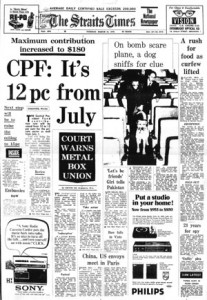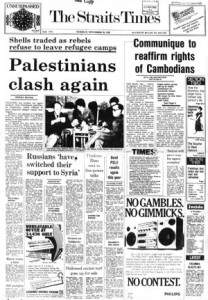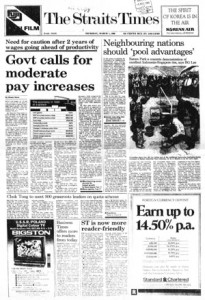Keeping up with the times – the changing look of Singapore’s longest surviving English newspaper The Straits Times.
— — — — — — — — — — — — — — — — — — — — — — — —
Introduction } 1960s } 1970s } 1980s } 1989 } 1998 } 2000s
— — — — — — — — — — — — — — — — — — — — — — — —
The Herald of a new face
The arrival of the Singapore Herald into the local newspaper market in July 1970 introduced competition to ST for the first time since its last competitor, The Tiger Standard, closed in 1959.
To take on the Herald, Khoo was sent back to Singapore from its Malaysian office to “brighten up” ST.[i] But the competition never quite materialised as the Singapore Herald was closed down amidst much controversy a year later.
As if assured of its monopoly, the paper stayed largely the same. In September 1972, ST became a Singapore-based paper when it parted company with its Malaysian assets, which became the New Straits Times.
ST’s design was changed to reflect this new status. To distinguish itself as a Singaporean paper, news from Malaysia was grouped into a section, Across the Causeway. In September 1973, the paper unveiled a new nameplate typeset in the modern-looking Bodoni and dropped its tagline altogether.
But the new nameplate was overshadowed by the paper changing to a ten-column grid from its previous eight because of a world-shortage of newsprint[ii]. An earlier switch to nine-columns was deemed insufficient with worsening strikes in the paper mills. With narrower columns and no luxury of white space, the paper became harder to read. Moreover, it was still using a mixture of typefaces to express variety and dramatisation of news, creating a cacophony of headlines for the reader.
By the second half of the 1970s, the paper had grown to over 30 pages from a 20-page read in 1959. It now had a regular Forum section to house readers’ letters. To aid the reader’s navigation of the thicker paper, an index, INSIDE, was introduced on the cover in March 1972.[iii] As and when it was necessary, the paper would also come in two parts.
One year after ST adopted its first formal editorial policy in 1977, it began carrying out its new stated mission “to inform, to educate, to activate and to entertain.”[iv]
The second part of ST was officially designated its leisure and educational supplement known as Section Two[v]. Inside, were the Leisure Page, Woman Plus, and the Bilingual page where readers could learn Chinese. However, the bulk of this new four to twenty-page section were actually just pages chock-full of advertisements.
To succeed in the Singapore market, ST wanted to provide content with mass appeal and quality to garner a maximum readership to attract advertisers, but its design, which was largely unchanged since 1959, was not keeping up with this new vision.
— — — —
- [i] Turnbull, 287.
- [ii] “From Today a Tenth Column,” The Straits Times, September 3 1978.
- [iii] First observed in The Straits Times, March 14 1972.
- [iv] Turnbull, 318.
- [v] “Change with the Times for Easier Reading,” The Straits Times, September 25 1978.
— — — —


